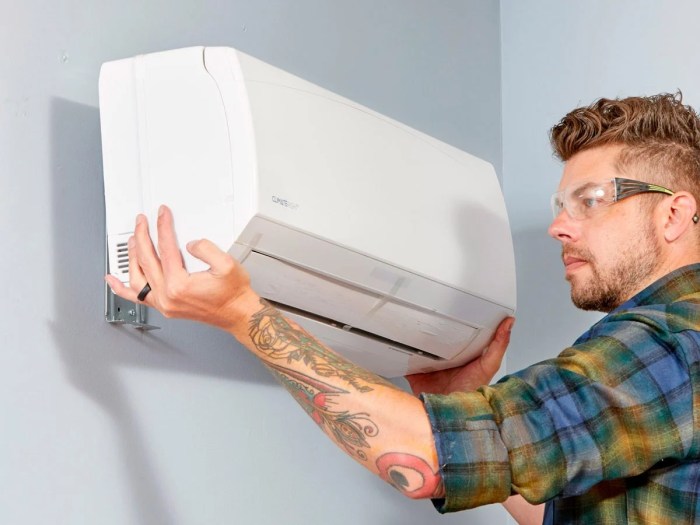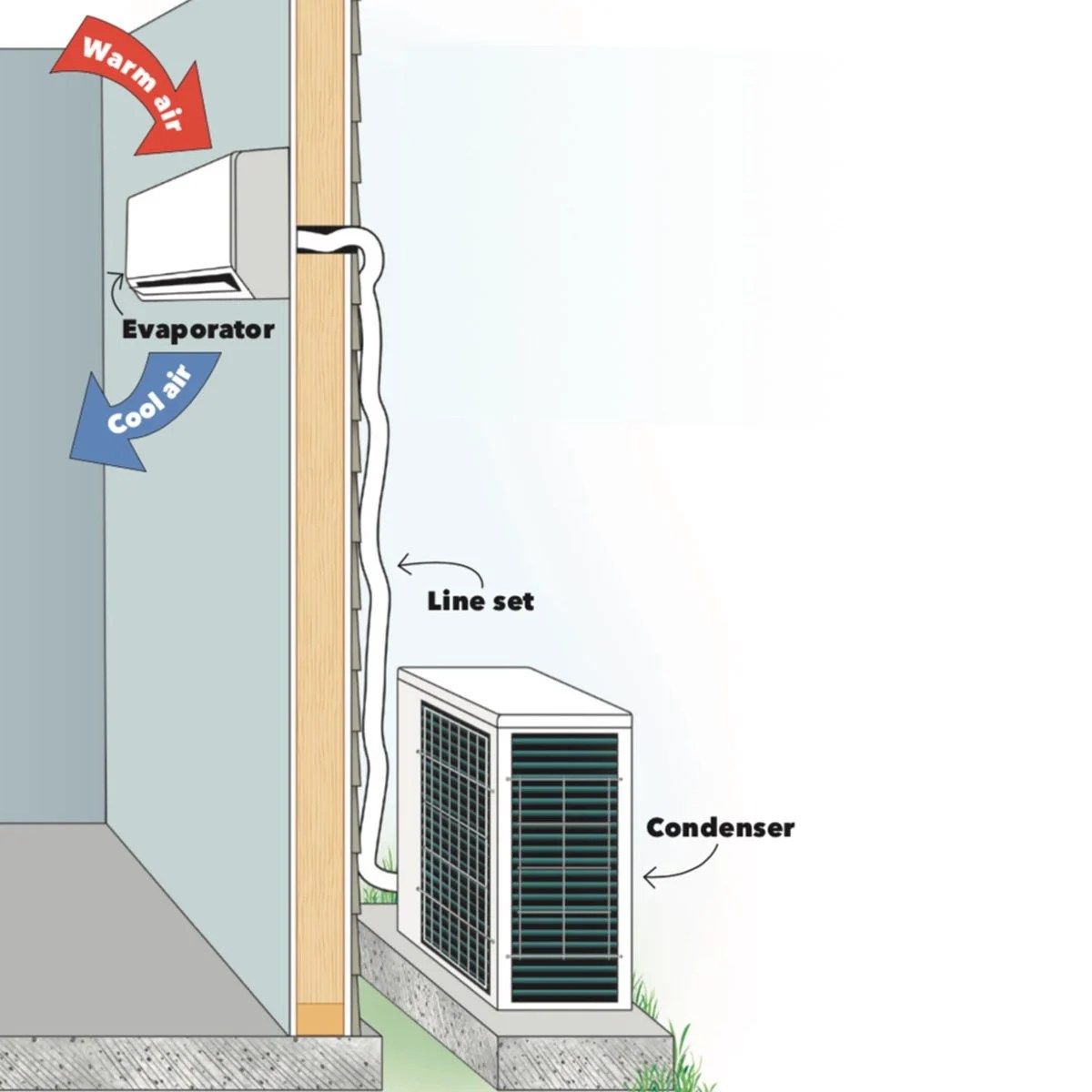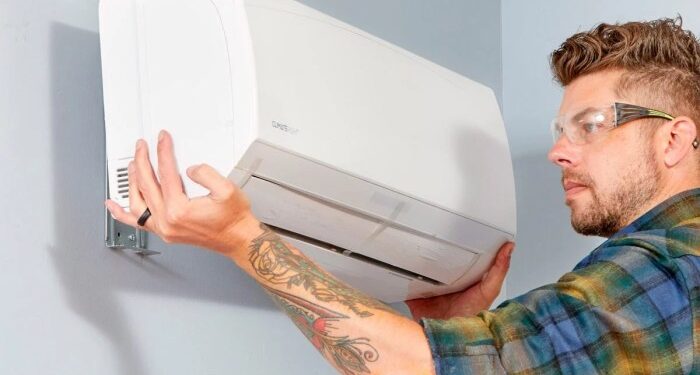How to install a ductless mini-split air conditioner sets the stage for this enthralling narrative, offering readers a glimpse into a story that is rich in detail with casual formal language style and brimming with originality from the outset.
Ductless mini-split air conditioners provide a modern solution for efficient cooling, but ensuring proper installation is crucial for optimal performance. This guide delves into the intricacies of installing these systems, covering everything from planning to maintenance.
Introduction
Ductless mini-split air conditioners are a popular cooling solution for homes and buildings. Unlike traditional AC units, ductless mini-splits do not require ductwork to distribute air, making them more energy-efficient and easier to install. Proper installation of a ductless mini-split AC is crucial to ensure optimal performance and efficiency.
Importance of Proper Installation
Proper installation of a ductless mini-split air conditioner is essential to maximize its cooling capabilities and ensure longevity. A professional installation ensures that the unit is placed correctly, refrigerant levels are accurate, and all connections are secure. Improper installation can lead to inefficiency, increased energy consumption, and potential breakdowns.
Benefits of Using a Ductless Mini-Split AC
- Energy Efficiency: Ductless mini-split ACs are highly energy-efficient, as they allow for zone cooling and heating, reducing energy waste.
- Flexible Installation: These units are easy to install and can be placed in various locations within a home or building.
- Improved Air Quality: Ductless mini-splits have multi-stage filtration systems that help improve indoor air quality by reducing dust, allergens, and other particles.
- Quiet Operation: These AC units operate quietly, providing a comfortable environment without the noise associated with traditional HVAC systems.
- Cost-Effective: While the initial cost of a ductless mini-split AC may be higher than traditional units, the long-term savings on energy bills make them a cost-effective cooling solution.
Planning for Installation

When installing a ductless mini-split air conditioner, it is crucial to carefully plan the placement of both the indoor and outdoor units, calculate the cooling capacity required for the room, and ensure the electrical requirements are met.
Selecting the Right Location for the Indoor and Outdoor Units
When choosing the location for the indoor unit, consider factors such as the size of the room, the layout of the space, and the direction of sunlight. It is important to place the indoor unit in a spot where the air can flow freely throughout the room without obstructions.
For the outdoor unit, select a location that is well-ventilated and easily accessible for maintenance.
Calculating the Cooling Capacity Needed for the Room
To determine the cooling capacity required for the room, calculate the square footage of the space and consider factors such as insulation, ceiling height, and the number of windows. Use the following formula to estimate the cooling capacity needed:
Cooling Capacity (BTU) = (Square footage x 25) + 450
This calculation will help you choose a ductless mini-split air conditioner with the right cooling capacity for efficient cooling.
Electrical Requirements for Installation
Before installing a ductless mini-split air conditioner, ensure that the electrical system in your home can support the unit. Most mini-split systems require a dedicated 110/120-volt or 220/240-volt circuit, depending on the model. It is important to consult a qualified electrician to assess the electrical requirements and ensure a safe and proper installation.
Tools and Materials Needed
Installing a ductless mini-split air conditioner requires specific tools and materials to ensure a successful and safe installation process. Additionally, having the necessary safety equipment is crucial to prevent accidents or injuries during the installation.
Tools Required for Installation
- Drill and drill bits
- Screwdriver (Phillips and flathead)
- Pliers
- Level
- Tape measure
- Hole saw
- Refrigeration wrench set
- Wire strippers
- Adjustable wrench
Materials Needed for Mounting the Indoor and Outdoor Units
- Mounting bracket for indoor unit
- L-brackets for outdoor unit
- Screws and bolts for securing units
- Outdoor unit mounting pad
- Piping and insulation kit
- Electrical whip
- Condensate drain tube
- Sealant or caulking
Safety Equipment Necessary During Installation
- Safety goggles
- Gloves
- Work boots
- Hard hat
- Protective mask
- Ear protection
Installation Process
When installing a ductless mini-split air conditioner, the process involves mounting the indoor unit on the wall, installing the outdoor unit, connecting the refrigerant lines, and making the necessary electrical connections.
Mounting the Indoor Unit on the Wall
To mount the indoor unit, you will need to select a suitable location on the wall that meets the manufacturer's guidelines for height and clearance. Use a mounting plate to secure the unit in place, ensuring it is level and properly supported.
Installing the Outdoor Unit
The outdoor unit should be placed in an area with good air circulation and minimal obstructions. It should be mounted securely on a stable surface to prevent vibrations. Make sure to follow the manufacturer's instructions for proper installation.
Connecting the Refrigerant Lines
Connect the refrigerant lines from the indoor unit to the outdoor unit using the appropriate tools and materials. Ensure that the lines are properly insulated to prevent heat loss and maintain efficiency. Vacuum test the lines to check for leaks before proceeding.
Electrical Connections and Testing
Make the necessary electrical connections following local electrical codes and guidelines. Test the system to ensure that it is functioning correctly, including checking the cooling and heating functions, as well as the remote control operation. Consult a professional if you are not familiar with electrical work.
Maintenance and Troubleshooting
Regular maintenance is key to ensuring your ductless mini-split air conditioner operates efficiently and lasts longer. By following some simple tips, you can keep your unit in top condition and avoid common issues that may arise. If problems do occur, knowing how to troubleshoot them can save you time and money.
Here are some maintenance and troubleshooting tips for ductless mini-split ACs:
Regular Maintenance Tips
- Keep the filters clean by washing or vacuuming them regularly to maintain good airflow and indoor air quality.
- Inspect the outdoor unit for any debris or obstructions that could affect its performance. Clear away any leaves, branches, or other items.
- Check the refrigerant levels and connections to ensure they are not leaking. Low refrigerant can affect the cooling capacity of the unit.
- Clean the evaporator and condenser coils to prevent dirt buildup, which can reduce the unit's efficiency.
- Inspect the drainage system to make sure it is clear and not clogged. A blocked drain can cause water leaks and damage to your unit.
Troubleshooting Common Issues
- If the unit is not cooling or heating properly, check the thermostat settings and ensure they are correctly adjusted.
- If the unit is making unusual noises, inspect the indoor and outdoor units for loose parts or debris that could be causing the issue.
- If the unit is leaking water, check the drainage system for clogs and make sure the unit is level to allow proper water drainage.
- If the unit is not turning on, check the power supply and circuit breaker to ensure there are no electrical issues causing the problem.
When to Seek Professional Help
- If you are unable to resolve an issue after troubleshooting or if you are uncomfortable performing maintenance tasks, it is best to seek professional help.
- Professional technicians can diagnose and repair more complex issues with your ductless mini-split AC while ensuring safety and efficiency.
- Regular maintenance by a professional can also help prevent major problems and prolong the lifespan of your unit.
Final Thoughts

In conclusion, mastering the installation of a ductless mini-split air conditioner opens the door to a world of comfort and efficiency. By following the steps Artikeld in this guide, you can enjoy the benefits of a well-installed system for years to come.
Essential Questionnaire
What is the ideal location for installing the indoor unit?
The indoor unit should be placed high on the wall, away from direct sunlight or heat sources for optimal performance.
What safety equipment is necessary during installation?
Safety goggles, gloves, and a mask are essential to protect yourself from any hazards during the installation process.
How often should ductless mini-split air conditioners be maintained?
Regular maintenance, including cleaning filters and checking for leaks, should be done at least once a year to ensure efficient operation.













